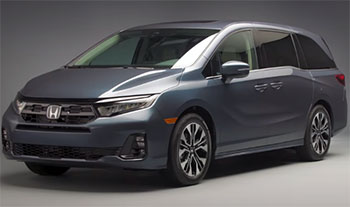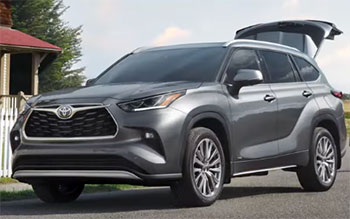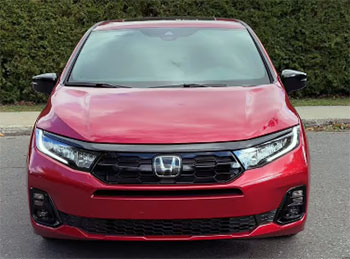As a parent navigating the chaos of family life, I’ve spent countless hours searching for the perfect vehicle to handle school runs, road trips, and everything in between. The 2025 Honda Odyssey and Toyota Highlander stand out as top contenders for families, each offering unique strengths. In this article, I’ll share my firsthand experiences, comparing their features, performance, and practicality to help you decide which suits your lifestyle. With a detailed comparison table, in-depth pros and cons, and answers to common questions, I aim to guide you through choosing between the minivan king and the SUV star.
Honda Odyssey vs. Toyota Highlander Comparison
| Feature | Honda Odyssey (2025) | Toyota Highlander (2025) |
|---|---|---|
| Vehicle Type | Minivan | Midsize SUV |
| Base Price | $40,703 | $41,955 |
| Engine | 3.5L V6 (280 hp, 262 lb-ft) | 2.4L Turbo 4-cylinder (265 hp, 310 lb-ft) |
| Hybrid Option | None | Available (2.5L 4-cylinder, 243 hp combined) |
| Fuel Economy (City/Hwy) | 19/28 mpg | 22/29 mpg (Gas), 36/35 mpg (Hybrid) |
| Seating Capacity | 7-8 | 7-8 |
| Cargo Space (Behind 3rd Row) | 32.8 cu. ft. | 16.0 cu. ft. |
| Max Cargo Space | 144.9 cu. ft. | 84.3 cu. ft. |
| Towing Capacity | 3,500 lbs | 5,000 lbs (Gas), 3,500 lbs (Hybrid) |
| All-Wheel Drive | Not Available | Available |
| Safety Rating (NHTSA) | 5 Stars | 5 Stars |
| IIHS Rating | Top Safety Pick | Top Safety Pick |
| Key Features | Magic Slide seats, CabinWatch, auto stop/start | Toyota Safety Sense 2.5+, panoramic view monitor, hybrid efficiency |
My Experience With the Honda Odyssey

When I first considered the 2025 Honda Odyssey, I’ll admit I wasn’t sold on the minivan life.
I pictured soccer moms and dated designs, but climbing into the Odyssey changed my mind.
The interior felt like a mobile command center for parents—spacious, intuitive, and packed with features that made my life easier.
I tested the Touring trim during a chaotic week of school drop-offs, grocery hauls, and a weekend camping trip.
The 3.5-liter V6 engine, pumping out 280 horsepower, handled everything from highway merges to city traffic with surprising agility.
The 10-speed automatic transmission shifted seamlessly, making the Odyssey feel less like a lumbering van and more like a refined family hauler.
The Magic Slide second-row seats were a revelation. With two kids in car seats, I could slide the seats apart to prevent sibling squabbles or move them forward for easy third-row access. During our camping trip, the 32.8 cubic feet of cargo space behind the third row swallowed a cooler, tent, and duffel bags without forcing me to play Tetris with our gear.
The low load floor made it easy for my five-year-old to climb in, and the sliding doors were a godsend in cramped parking lots at the grocery store.
The CabinWatch system, a camera that displays rear passengers on the 8-inch touchscreen, let me keep an eye on my napping toddler without turning around. CabinTalk, which projects my voice to the back through the speakers, meant I didn’t have to yell to get my kids’ attention.
On our four-hour drive to the campsite, the rear-seat entertainment system with a 10.2-inch screen kept my kids glued to their movie, giving me and my spouse a rare moment of peace. The Odyssey’s fuel economy, at 19 mpg city and 28 mpg highway, wasn’t outstanding, but the auto stop/start system helped stretch my gas budget in stop-and-go traffic.
However, the lack of all-wheel drive was noticeable when we hit a muddy trailhead. I felt a bit uneasy navigating slick patches, especially compared to SUVs I’ve driven. The Odyssey’s exterior, while refreshed for 2025, still screams “minivan,” which might not appeal to everyone.
Despite these drawbacks, its practicality won me over. It’s built for parents who need a vehicle that adapts to the unpredictable demands of family life, from hauling sports equipment to surviving long road trips.
My Experience With the Toyota Highlander

The 2025 Toyota Highlander, on the other hand, felt like the cooler cousin of the Odyssey. Its bold front grille and sleek lines gave it a rugged, modern vibe that turned heads in my neighborhood.
I tested both the gas-powered XLE trim and the hybrid Platinum trim over a week that included rainy commutes, a trip to the hardware store, and a family outing to a local lake.
The standard 2.4-liter turbo four-cylinder engine, with 265 horsepower, offered peppy acceleration, though I noticed slight turbo lag when merging onto highways.
The hybrid’s 2.5-liter four-cylinder and electric motors, delivering 243 horsepower combined, were smoother and impressively efficient at 36 mpg city.
The Highlander’s interior felt upscale, especially in the Platinum trim. The 12.3-inch touchscreen was crisp and responsive, and the wireless charging pad kept my phone juiced during busy days.
The second-row captain’s chairs were plush, but the third row was tight for my 6-foot-tall brother-in-law, who grumbled during our lake trip. Cargo space behind the third row, at 16 cubic feet, was enough for grocery bags but struggled with bulkier items like a folded stroller. Folding the third row flat opened up 84.3 cubic feet, which was decent but couldn’t match the Odyssey’s cavernous hold.
The Highlander’s all-wheel drive was a game-changer on wet roads, giving me confidence during a rainy commute. Its 5,000-pound towing capacity (gas model) was perfect for pulling our small camper, something the Odyssey couldn’t handle as well.
Toyota Safety Sense 2.5+ impressed me with features like adaptive cruise control and lane-tracing assist, though the latter felt overly aggressive on winding roads, nudging the steering wheel more than I liked. The panoramic view monitor, with cameras showing every angle, made parallel parking in tight spaces a breeze.
While the Highlander felt versatile and stylish, it didn’t have the Odyssey’s sheer space or seating flexibility. Still, it appealed to my desire for a vehicle that could handle family duties while looking sharp and offering hybrid efficiency for my daily drives.
Pros Of the Honda Odyssey

- Unmatched Interior Space: The Odyssey’s 144.9 cubic feet of max cargo space is a lifesaver. During our camping trip, I packed a double stroller, a cooler, and four duffel bags with room to spare. The 32.8 cubic feet behind the third row handled weekly grocery runs effortlessly.
- Magic Slide Seats: These second-row seats slide side-to-side or forward, making configurations endless. I could separate my bickering kids or create a walkway to the third row without uninstalling car seats, a huge win for busy mornings.
- Family-Centric Technology: CabinWatch let me monitor my sleeping toddler on the touchscreen, while CabinTalk amplified my voice to the back, saving my vocal cords. The rear-seat entertainment system kept my kids entertained for hours, reducing road-trip meltdowns.
- Smooth and Powerful: The 3.5-liter V6 and 10-speed automatic made highway driving a breeze. I merged onto I-95 with confidence, and the Odyssey handled tight turns in my neighborhood surprisingly well for its size.
- Top-Tier Safety: With a 5-star NHTSA rating and IIHS Top Safety Pick, the Odyssey’s Honda Sensing suite (adaptive cruise, lane-keeping assist, auto braking) gave me peace of mind, especially in heavy traffic.
- Clever Storage Solutions: From underfloor storage to multiple cupholders, the Odyssey made organizing kid gear easy. I stashed snacks, toys, and even a first-aid kit in its many cubbies, keeping the cabin clutter-free.
- Proven Reliability: Honda’s 8.7/10 reliability score from iSeeCars and strong J.D. Power rankings reassured me. During my test, the build quality felt rock-solid, with no rattles or issues.
- Low Load Floor: The Odyssey’s low step-in height made it easy for my kids to climb aboard, and loading heavy items like a bike was effortless compared to taller SUVs.
- Sliding Doors: In tight parking lots, the power sliding doors were a godsend, letting my kids get in and out without dinging neighboring cars.
The Odyssey’s interior versatility was a standout. During a school fundraiser, I hauled tables and chairs with ease, thanks to the removable second-row seats and fold-flat third row. The sliding doors and low floor were perfect for my elderly parents, who found getting in and out a breeze. While not flashy, the Odyssey’s design screams functionality, making it a top choice for families who value practicality over aesthetics.
Read More: My Thoughts On Acura MDX Vs. Jeep Grand Cherokee
Cons Of the Honda Odyssey
- No All-Wheel Drive: The lack of AWD was a letdown during a rainy camping trip. Navigating a muddy trailhead felt dicey, and I envied the Highlander’s surefootedness in similar conditions.
- Minivan Stigma: Despite its updates, the Odyssey’s boxy look drew smirks from friends who prefer SUVs. I felt a bit self-conscious pulling up to social events, as it lacks the Highlander’s sleek vibe.
- Mediocre Fuel Economy: At 19/28 mpg, the Odyssey guzzled more gas than the Highlander Hybrid. A 300-mile road trip cost me about $15 more in fuel than it would have in the hybrid.
- Expensive Upper Trims: The base model starts at $40,703, but the Elite trim I tested pushed past $50,000. Features like the 11-speaker audio system were locked behind higher trims, which felt limiting.
- Heavy Second-Row Seats: Removing the Magic Slide seats for max cargo space was a workout. I struggled to lift them out alone, making quick reconfigurations less practical than I’d hoped.
- No Hybrid Option: Without a hybrid powertrain, the Odyssey misses out on the fuel savings and eco-appeal of competitors like the Toyota Sienna or Highlander Hybrid.
- Dated Infotainment: The 8-inch touchscreen in lower trims felt small and less modern than the Highlander’s 12.3-inch display. Navigation and menus were functional but lacked the polish I expected.
- Noise at High Speeds: On the highway, I noticed more wind noise than in the Highlander, especially above 70 mph, which made conversations slightly harder without raising my voice.
The Odyssey’s lack of AWD was a real concern for me, as I live in an area with occasional snow. The minivan design, while practical, didn’t spark joy like the Highlander’s sporty look. Fuel costs added up on longer trips, and the infotainment system felt a step behind competitors. Still, these flaws didn’t overshadow its family-friendly brilliance.
Pros Of the Toyota Highlander
- Hybrid Fuel Efficiency: The Highlander Hybrid’s 36/35 mpg was a budget-saver. During a week of commuting, I spent about $20 less on gas than with the Odyssey, a big deal for daily drivers.
- All-Wheel Drive Versatility: AWD gave me confidence on wet roads and gravel paths. During a rainy lake trip, the Highlander felt planted, unlike the Odyssey’s occasional slipperiness.
- Impressive Towing: The gas model’s 5,000-pound towing capacity handled my small camper with ease, perfect for weekend getaways. The Odyssey’s 3,500-pound limit felt restrictive by comparison.
- Stylish Design: The Highlander’s bold grille and sleek lines earned compliments everywhere I went. It felt modern and rugged, appealing to my desire for a vehicle with personality.
- Advanced Safety Features: Toyota Safety Sense 2.5+ includes adaptive cruise, lane-tracing assist, and road sign recognition. The panoramic view monitor made parking in tight spots stress-free.
- Premium Interior: The Platinum trim’s leather seats, heated steering wheel, and 12.3-inch touchscreen felt luxurious. I loved the wireless charger and ample storage for my kids’ snacks and devices.
- Strong Reliability: With an 8.9/10 iSeeCars rating and Toyota’s reputation, the Highlander felt like a safe bet for long-term ownership. My test drives showed no signs of wear or rattles.
- Quiet Cabin: Even at highway speeds, the Highlander’s cabin was hushed, making it easy to chat with my spouse or hear my kids in the back without straining.
- Flexible Trim Options: From the base LE to the loaded Platinum, the Highlander offers choices for every budget, with features like a power liftgate standard across most trims.
The Highlander’s hybrid efficiency was a highlight, especially for my 30-mile daily commute. AWD made it a great fit for my occasional off-road adventures, and the towing capacity was a bonus for camping trips. The stylish design and upscale interior made me feel like I was driving something special, not just a family hauler.
Cons Of the Toyota Highlander
- Tight Third Row: The third row was cramped for adults. During our lake trip, my brother-in-law struggled to fit comfortably, making it better suited for kids than grown-ups.
- Limited Cargo Space: With just 16 cubic feet behind the third row, I couldn’t fit a stroller without folding seats. The Odyssey’s 32.8 cubic feet was far more practical for daily use.
- Higher Hybrid Cost: The hybrid starts at a premium, and adding AWD or the Platinum trim pushed the price near $54,000, a stretch for budget-conscious families like mine.
- Overzealous Lane Assist: The lane-tracing system tugged the steering wheel on curvy roads, which felt intrusive. I turned it off during a winding drive to avoid the constant corrections.
- Premium Fuel for Hybrid Max: The Hybrid Max model requires premium fuel, costing me about $4.50 per gallon versus $3.65 for the Odyssey’s regular unleaded, adding up over time.
- Less Seat Flexibility: The Highlander’s second-row seats don’t slide or reconfigure like the Odyssey’s Magic Slide seats, making third-row access trickier, especially with car seats installed.
- Turbo Lag in Gas Model: The 2.4-liter turbo engine had noticeable lag when accelerating from a stop, which was frustrating in stop-and-go traffic compared to the Odyssey’s smoother V6.
- Smaller Max Cargo: Even with seats folded, the Highlander’s 84.3 cubic feet of cargo space couldn’t match the Odyssey’s 144.9, limiting its hauling capacity for big trips.
The Highlander’s third row and cargo space were its biggest weaknesses. I struggled to fit larger items for a school event, and the tight third row meant adults were relegated to the front. The hybrid’s cost and premium fuel needs gave me pause, and the less flexible seating made it harder to adapt to my family’s needs compared to the Odyssey.
Read More: My Thoughts On BMW X7 Vs. Cadillac Escalade
Frequently Asked Questions (FAQ)
The Toyota Sienna is the closest match to the Honda Odyssey, as both are minivans with similar seating (7-8 passengers) and cargo capacities (33.5 vs. 32.8 cubic feet behind the third row). The Highlander, while versatile, is an SUV with less interior volume and a different focus.
The Honda Pilot and Kia Telluride often edge out the Highlander due to their roomier third rows and more flexible seating arrangements. The Pilot offers up to 111.8 cubic feet of cargo space, while the Telluride boasts premium features and a smoother ride, depending on your priorities.
Highlanders are a hit thanks to their blend of reliability, with an 8.9/10 iSeeCars score, and a hybrid option that delivers 36 mpg. Their stylish design, all-wheel drive, and Toyota Safety Sense 2.5+ appeal to families wanting a versatile, safe SUV with strong resale value.
Absolutely, the Honda Odyssey is a reliable choice, scoring 8.7/10 from iSeeCars and ranking well in J.D. Power’s quality studies. Its durable V6 engine and solid build quality mean fewer trips to the mechanic, making it a trusted family workhorse.
Conclusion: For Honda Odyssey and Toyota Highlander
Deciding between the Honda Odyssey and Toyota Highlander comes down to what you value most for your family. If you need maximum space, flexible seating, and minivan practicality, the Odyssey is your best bet. Its Magic Slide seats, massive cargo hold, and family-focused tech like CabinWatch make it a parent’s dream for school runs, road trips, and chaotic schedules. However, you’ll miss all-wheel drive and hybrid efficiency, and its boxy look might not win style points. If you prefer a stylish SUV with better fuel economy and towing power, the Highlander shines. Its hybrid option saves money at the pump, and all-wheel drive handles tough weather, but the cramped third row and limited cargo space may frustrate larger families. I recommend test-driving both to see which feels right for your daily grind and weekend adventures. Your lifestyle—whether it’s hauling sports gear or towing a camper—will point you to the perfect choice.

